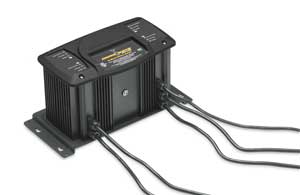
Learning all you can about the dynamics of the Gulf of Mexico will greatly increase your haul from the “big water.”
The deep-cycle batteries that power electric trolling motors and serve as house batteries on pleasure boats are built to last for a certain number of full discharge/recharge cycles. The more expensive the battery, the more cycles it generally lasts. I say “generally” because improper charging and other poor maintenance practices can significantly reduce a battery’s life regardless of how much it costs.
Flooded-cell, full-maintenance batteries give you the most amps per dollar and per pound, but they are also the most susceptible to owner-caused damage.
The water in each cell must be kept at the proper level, and the battery’s top and post terminals must be kept clean. Finally, the battery must be charged as soon as possible after use and kept at least 75 percent charged while stored.
When the water level in a cell drops below the plates, the electrolyte can’t interact with the plate area that’s high and dry, and you lose that percentage of the cell’s ability to produce power or take a charge. Dry plates can get hot enough to warp and touch each other, permanently ruining the battery. A crud build-up on the battery’s top can form an electric bridge between the posts, a subtle short that bleeds off power you don’t get to use. Dirty terminal connections can prevent the battery from delivering full power or taking a full charge.
Acid from the electrolyte combines with the plates as a battery discharges, and the recharging process knocks it loose and puts it back into the electrolyte.
If you let a battery sit around discharged for days, the acid begins to form a crust on the plates and becomes more difficult to dislodge. The crust, called sulfation, insulates the plate area under it from the electrolyte and decreases battery efficiency.
Starting the recharging process as soon as possible after a day on the water prevents sulfation and ensures that your rig is ready to go again in short order.
Properly recharging a battery means measuring the battery’s present charge level, calculating how long it will take your charger to completely recharge it, hooking up your charger for that length of time and then disconnecting it to prevent overcharging. Maintaining the charge requires regular state-of-charge checks and carefully recharging as necessary.
Or you can install an onboard automatic charger, and forget all that.
Today’s onboard chargers are designed to top off your batteries after a day on the water, and keep them hot until your next trip. Drag an extension cord out to your boat, plug in the charger and it does all the measuring and calculating for you, and then applies and maintains just the right amount of charge. All you have to do is keep the batteries watered and clean, and if you use sealed, maintenance-free AGM batteries, you can forget about adding water, and cleanings won’t be necessary as often because nothing spews out of them during charging.
Extra care is required if you use gel batteries instead of flooded or AGM types because most onboard chargers are too hot for gel batteries and are not recommended for them.
Onboard chargers are easy to install and hook up, and models are available with up to four sets of charging leads (you need one set for each battery). Just mount the charger in or near the battery compartment, and route a set of leads to each battery, connecting the red lead to its positive post and the black lead to its negative post. Plug the charger into an AC outlet, and your batteries are charging.
The more amps a charger sends to each set of leads, the faster it recharges your batteries. Some smart chargers have a stated total amp output instead of a stated output for each set of leads. These models check all your batteries and divide the charge up between them according to each battery’s need.
A charger that puts out six or eight amps per set of leads is plenty if you generally have a full night or more of charging time between trips. The less down time you have between outings the more charging power you need per bank because the charger has less time to work.
Most of us would rather sit down and put our feet up after a hard day on the water than spend an hour messing with batteries. Onboard chargers let us do just that.


